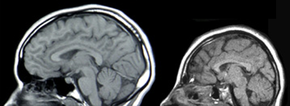Microcephaly
| Classification according to ICD-10 | |
|---|---|
| Q02 | Microcephaly - Hydromicrocephaly - Micrencephaly |
| ICD-10 online (WHO version 2019) | |
A microcephaly (also written microcephaly ; from the Greek μικρός mikrós "small" and κεφαλή kephalē "head") is a developmental peculiarity in humans in which the head is comparatively small; the head circumference is three standard deviations less than the mean value for a person of the same age and gender. For those affected, microcephaly is accompanied by an intellectual disability , the intensity of which depends on the extent and on the accompanying dysfunction. The frequency is 1.6 per 1,000 births.
Reasons for this can be an incorrect development of the brain ( dyscephaly , microencephaly ) or a premature closure of the cranial sutures ( craniostenosis ) with the resulting dyscrania or microcrania .
causes
A microcephaly or the developments leading to this peculiarity, e.g. B. by:
- an infection with rubella or the Zika virus or cytomegalovirus during pregnancy in the mother .
- Chromosome peculiarities , as they are e.g. B. Cri-du-chat syndrome , Angelman syndrome , Kabuki syndrome , Nijmegen breakage syndrome , trisomy 14 or Down syndrome are the cause .
- The metabolic disorder phenylketonuria .
- Likewise, this is fetal alcohol syndrome , a common cause of microcephaly.
- Crystal meth abuse in pregnancy.
- Microcephaly can also occur with some syndromes such as: B. Renpenning syndrome , autosomal recessive primary microcephaly , Paine syndrome , Galloway syndrome or Nicolaides-Baraitser syndrome .
Radiation-induced microcephaly
The radiation-induced microcephaly ( lat. Inducere "initiate") refers to one in several epidemiological observed specificity studies in children in the course of pregnancy, an increased radiation exposure were exposed z. B. due to therapeutic radiation because of cancer treatment of the mother or radiation exposure, as can be demonstrated in atomic bomb victims or the like. The occurrence of microcephaly depends on the radiation dose. The radiation doses necessary to trigger this embryotoxic damage are above 0.1 Gy (10 rd ), after a dose of 0.5 Gy (50 rd) a high incidence must be expected. The sensitive period lies in the 8th to 15th week of pregnancy when the nerve cells develop.
See also
For a discussion of the possible or presumed microcephaly in Homo floresiensis, see Homo floresiensis # controversy .
Individual evidence
- ↑ Carol M. Rumack, SR Wilson, JW Charboneau, D. Levine: Diagnostic Ultrasound. 4th edition, Elsevier / Mosby, Philadelphia PA 2011, ISBN 978-0-323-05397-6 , p. 1224.
- ↑ Jörg Baltzer, Klaus Friese, Michael Graf, Friedrich Wolff (eds.): Practice of gynecology and obstetrics. Thieme, Stuttgart 2006, ISBN 978-3-13-144261-1 , p. 314 f.
- ↑ Zika undoubtedly causes malformations . On: tagesschau.de from April 14, 2016; last accessed on April 14, 2016.
- ↑ Crystal meth in pregnancy - effects on mothers and children. Deutschlandfunk, accessed on June 25, 2017 .

